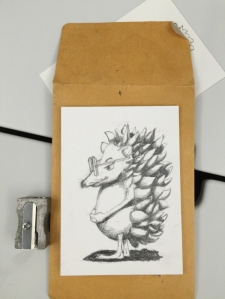Did you notice the surge of illustrations on social media in October? Have you heard about Inktober? What about Mab’s Drawlloween Club? Both provide a drawing prompt for everyday of October. Anyone can participate by sharing their illustration and tagging it with the challenge name. Inktober, created by Jake Parker, has topics which are perhaps broader in scope. Mab Graves, creator of Drawlloween, makes prompts oriented to Halloween or horror genres.
I’ve wanted to do Inktober for a couple years but was a little shy to do it on my own. This year, an artist friend started a small group on Facebook to support each other through the Drawlloween challenges. Sharing the art more widely on social media was optional. Perfect!
The idea of some kind of daily practice without a lot of pressure was really appealing. But I didn’t want to get too caught up in this challenge while I had other obligations. I set a few personal rules:
1. Try to spend no more than 20 minutes on a sketch
2. Try to use a medium I’m not good at or comfortable with.
3. You have permission to make bad drawings
Week 1:
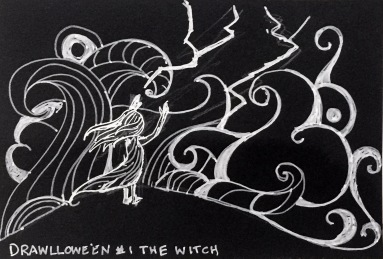
Day1: Witch (white pen)

Day 2: Cat (pen)

Day 3: Cryptid (digital)

Day 4: Mushroom (photo-base vector)

Day 5: Lab

Day 6: Ghost

Day 7: Haunted Object (Copic marker)
LIKES: The Cat, the mushrooms, the haunted object
DISLIKES: The witch, the lab. Mainly time issues. My idea for the lab was an old alchemist lab but… ideas bigger than my skill.
DISCOVERIES: I’m not as good at pencil drawing as I thought. Drawing on Post-Its is awesome. White ink on black paper isn’t what I thought it would be. WORK SMALLER!
Week 2:

Day 8: Yokai (graphite)

Day 9: Spider Babies (pen)

Day 10: Lagoon Creature (ink)
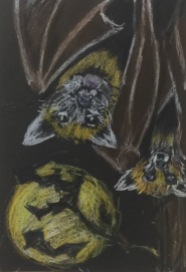
Day 11: Bat (wax crayon)

Day 12: Vampire (ink pen)

Day 13: Grave (ink pen)

Day 14: Skeleton (ink pen)
LIKES: The yokai, the lagoon creature, the vampire.
DISLIKE: The skeleton. It was freaking hard, couldn’t put in the time and it shows. 😦
DISCOVERIES: I love the idea for spider babies. I’ve m finding that some of my ideas are not going to happen in a single, quick, sketch. I’m spending time on pen and ink and I think I’m getting a bit better.
Week 3:

Day 15: Owl (ink)

Day 15: Owl (copic marker)

Day 16: Goblin (wax crayon)
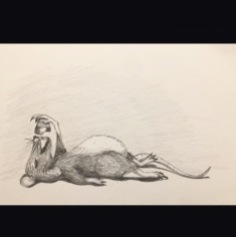
Day 18: Rat (graphite)

Day 19: Seance (guache)

Day 20: Serpent (digital)

Day 17: Werewolf (ink pen)

Day 21: Alien (graphite. digital manipulation)
LIKES: Werewolf, Rat
DISLIKES: Seance
DISCOVERIES: The wax crayon (Caran d’Ache) was fun but I have to relax on detail control with them. My determination to make the white on black paper is… I just need to let that go.
Week 4:

Day 23: Monster (pen)

Day 22: Pumpkin (pen)

Day 24: Hunter’s Moon (pen)

Day 25: Dark Forest (watercolour pen)

Day 26: Toad (pen)

Day 27: Swamp Thing (pen)
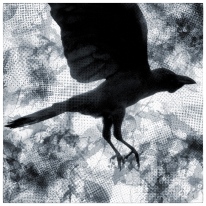
Day 28: Ravens (digital photo)
LIKES: I like the pun for pumpkin. The Lint Monster (which was surprisingly popular) but I’m not a fan of anything in particular.
DISLIKES: Pretty much this whole week, especially the forest.
DISCOVERIES: Super swamped with deadlines and visiting family in the hospital. I wasn’t doing these daily. At first I was excited by the prompts and then I found them excruciating. The watercolour pens for the forest annoy the heck out of me. I’m frustrated and annoyed with the stuff I’m making but since I’m 21 days in, I’m not going to quit. I liberally applied the DONE IS BETTER THAN PERFECT rule.
Final Days:

Day 29: Mary Shelley

Day 30: Bride

Day 31: Frankenstein
LIKES: Mary Shelley was the one I was least keen on at first. It’s my favourite. Victor Frankenstein is a single line drawing. The Bride… I find it funny.
DISLIKES: Not this week!
DISCOVERIES: By this time I’m caught up and doing one a day. I think these are the best ones of the series. I took way longer than my allowed 20 minutes. My image of Dr. Frankenstein’s lab was similar to the day 5 challenge. I barely avoided that rabbit hole.
THE FAVORITES GALLERY:

Day 31: Frankenstein

Day 30: Bride

Day 29: Mary Shelley

Day 10: Lagoon Creature (ink)

Day 12: Vampire (ink pen)

Day 17: Werewolf (ink pen)

Day 18: Rat (graphite)

Day 7: Haunted Object (Copic marker)

Day 8: Yokai (graphite)
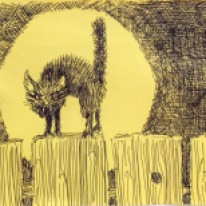
Day 2: Cat (pen)

Day 15: Owl (ink)
SUMMING UP
Daily Practice: Momentum in a project is really a thing.
At the beginning, the idea of daily practice really appealed to me. By the third week, I’d fallen behind and started to get stressed. But having done 21 drawings gave me that extra push to make sure that I completed the challenge even though I was doing multiple drawings on some days.
Time Management: Reflect, compromise and know yourself?
No surprise that investing time gives better results. My favourite images took way more time than I planned. The biggest struggle here was letting go of certain visions in order to meet deadlines. A couple things were good: working smaller, use whatever is on hand (result was drawing on Post-its). I was really inspired by the artists I did the challenge with. They inspired me to make my work as good as possible. The drawback was frustration. I know I could do better with more time. It was also easy to start comparing myself to them and that was totally not the point of the challenge. More importantly, we are all on different points of our artist journey and I think comparing yourself to another artist is a waste of time and harmful.
Different Media/ Technique Challenge: good to try new things but great to be in the comfort zone
I felt like pen and ink work improved a lot. Using black paper didn’t work out how I expected. The guache was better than white ink pen and the coloured pencil on black paper… no. I feel like I needed to try a wider variety of techniques. I realized my pencil drawing technique is not as good as I thought. That’s fine. It’s good to know what to work on.
Permission to make bad drawings: taken at full face value
This permission also freed me up to try different techniques. Even when I didn’t like the direction of the sketch I kept going. For me and this kind of practice, it’s important to say done is better than perfect. It also helped me with time management.
Anyway, a very long wrap-up of my daily art practice with Drawlloween. If you’re curious about any of the drawings, feel free to comment.
Also, if you have any art medium or techniques you recommend let me know. I do love to experiment.



 How long have your been making sequential art?
How long have your been making sequential art?






















































 I met Tania Vicedo on the day of the Monogatari Release party set up. I love the pared-down style of her images. She really gets to the essence of her subject. I enjoyed speaking with her about her work. She graciously took the time to answer questions about her art and creative process for her story in Monogatari.
I met Tania Vicedo on the day of the Monogatari Release party set up. I love the pared-down style of her images. She really gets to the essence of her subject. I enjoyed speaking with her about her work. She graciously took the time to answer questions about her art and creative process for her story in Monogatari.














